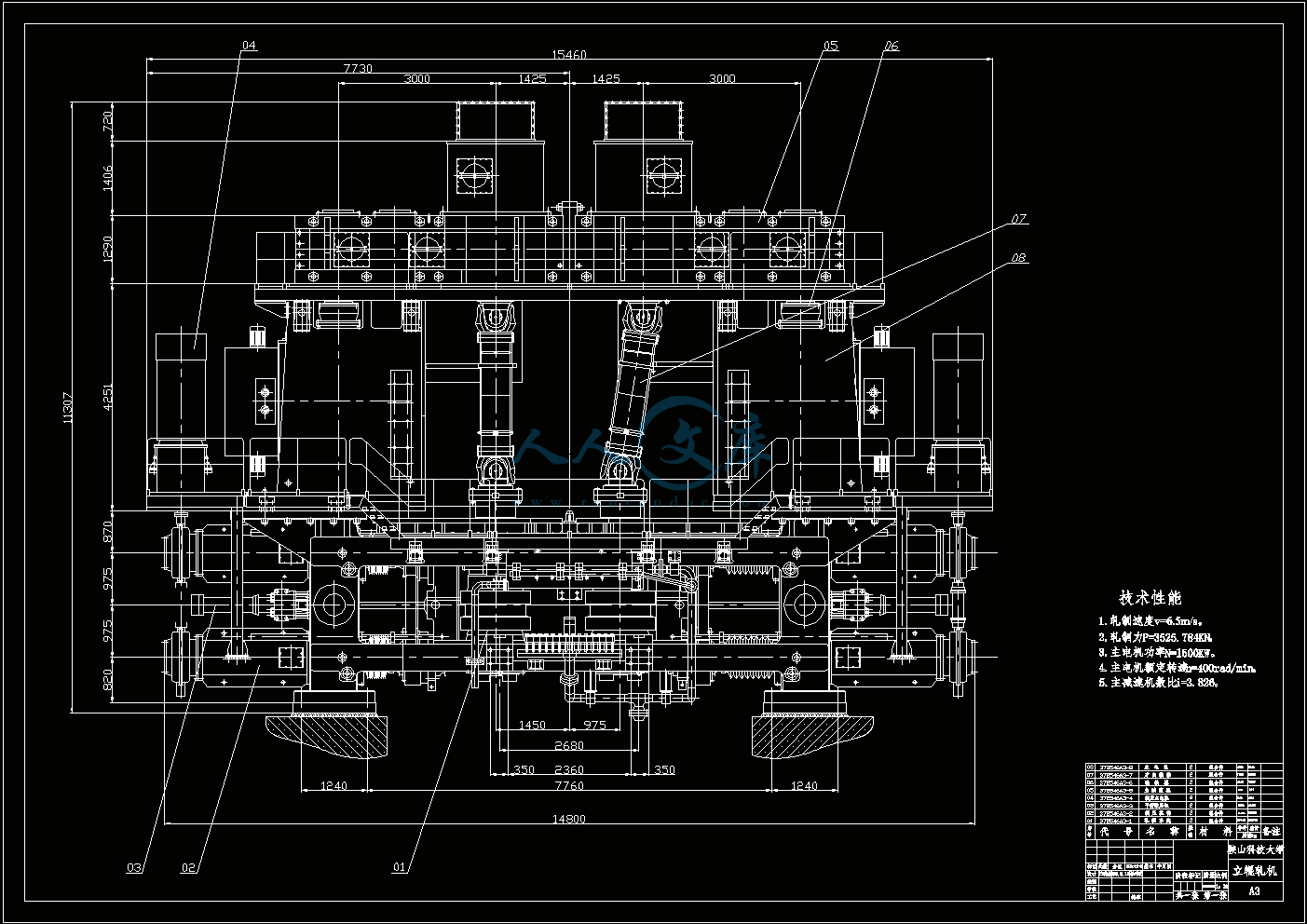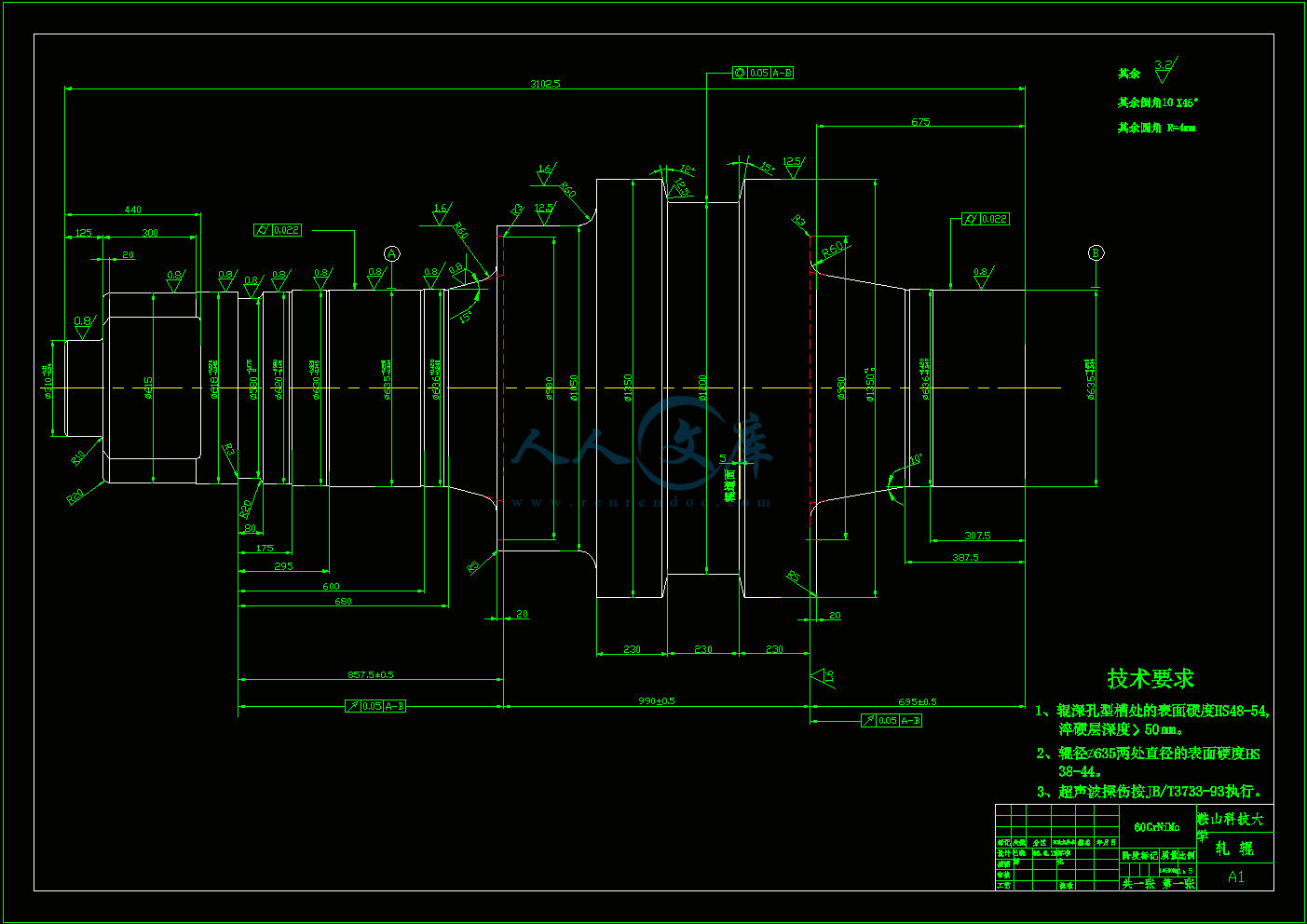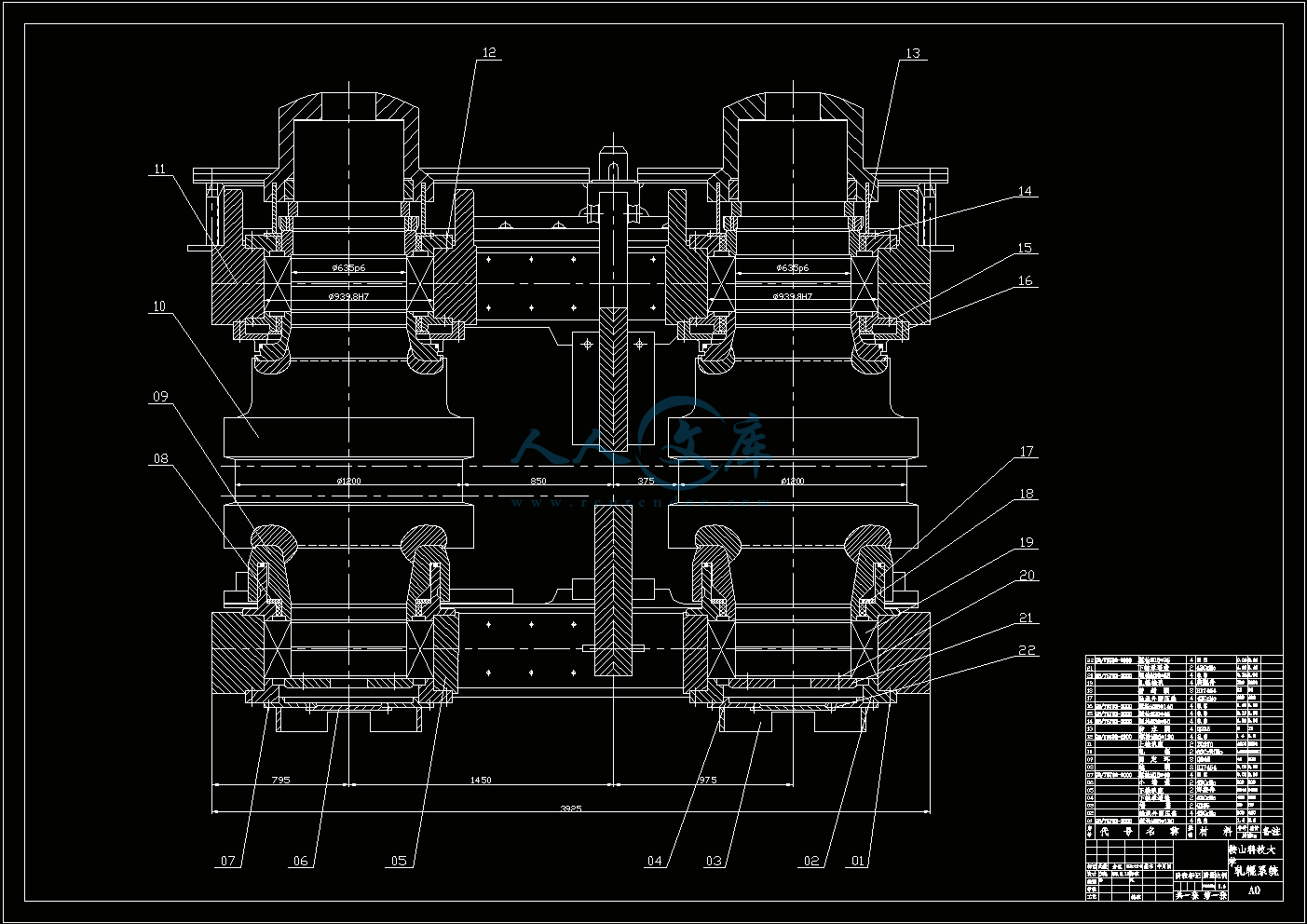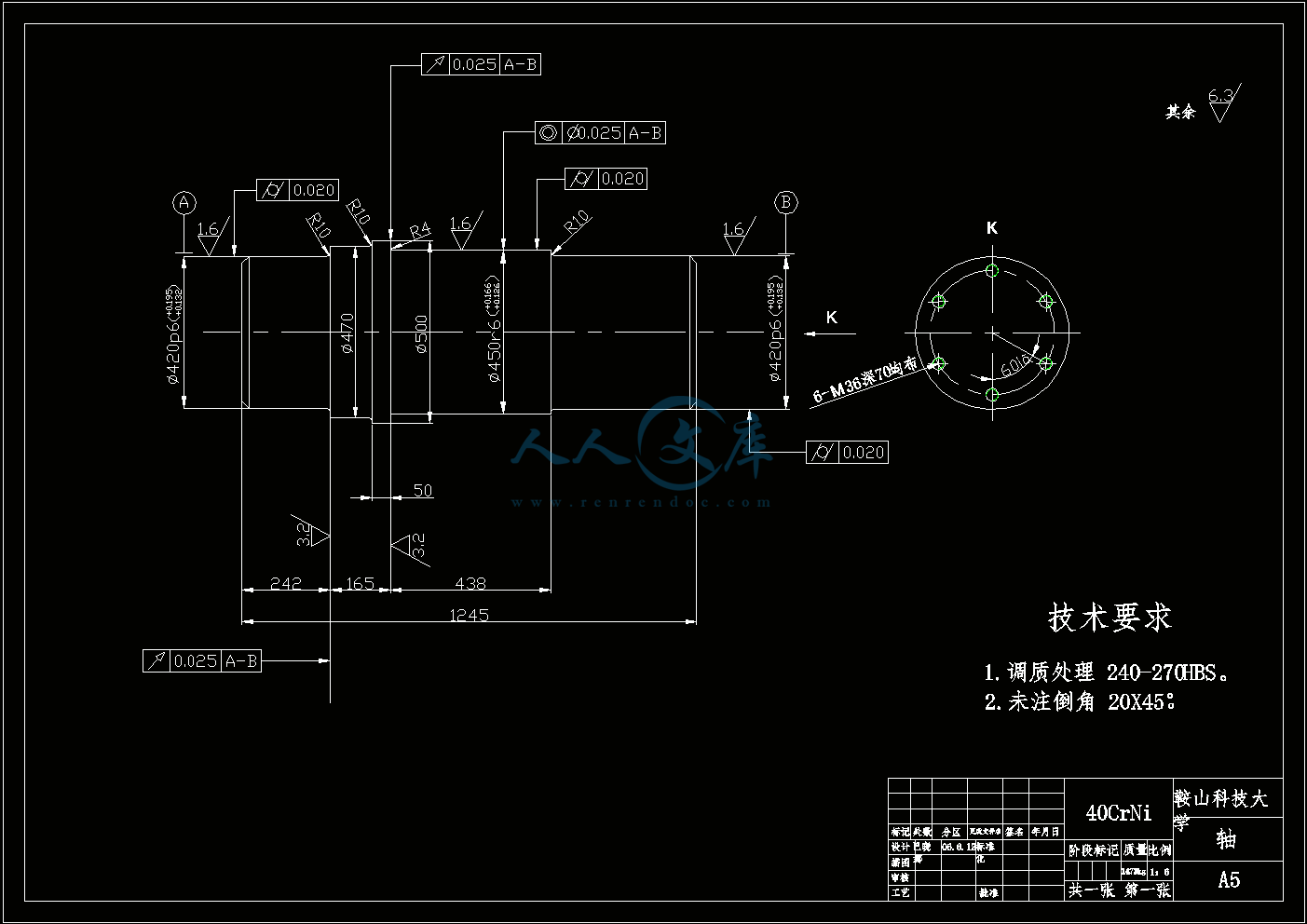立辊轧机主传动系统设计
41页 13000字数+说明书+外文翻译+5张CAD图纸【详情如下】
外文翻译--辊缝润滑工作辊冷却及反剥系统在热轧钢机上的协调应用.doc
总装图.dwg
摘要.doc
立辊轧机主传动系统设计说明书.doc
轧辊装配图.dwg
轧辊零件图.dwg
轴.dwg
齿轮轴.dwg






目录
1.绪论 …………………………………………………………………………………… 1
1.1 选题背景及目的…………………………………………………………………… 1
1.1.1选题背景…………………………………………………………………………… 1
1.1.2选题目的…………………………………………………………………………… 1
1.2 热轧宽带钢国内外发展状况……………………………………………………… 1
1.2.1国外热轧宽带钢生产技术的发展史……………………………………………… 1
1.2.2我国热轧宽带钢生产技术的进步………………………………………………… 2
2.立辊轧机简介 ………………………………………………………………………… 4
2.1 立辊轧机的发展状况……………………………………………………………… 4
2.1.1立辊轧机的发展…………………………………………………………………… 4
2.1.2新型立辊轧机的使用情况………………………………………………………… 4
2.2 立辊轧机特点介绍………………………………………………………………… 4
2.2.1立辊轧机的特点…………………………………………………………………… 4
2.2.2立辊轧机的作用…………………………………………………………………… 5
2.2.3立辊轧机的分类…………………………………………………………………… 5
2.2.4立辊轧机的组成…………………………………………………………………… 5
3.总体方案的确定 ……………………………………………………………………… 6
3.1 主传动系统………………………………………………………………………… 6
3.2 万向接轴…………………………………………………………………………… 7
3.3 轧辊系统…………………………………………………………………………… 7
3.4 轧辊轴承…………………………………………………………………………… 8
3.5 侧压系统…………………………………………………………………………… 9
4.立辊轧机力能参数的计算 …………………………………………………………… 10
4.1 立辊轧机轧制力计算……………………………………………………………… 10
4.1.1影响应力计算因素………………………………………………………………… 10
4.1.2应力计算…………………………………………………………………………… 12
4.1.3立辊轧机轧制力计算……………………………………………………………… 12
4.2 立辊轧机轧辊力矩计算…………………………………………………………… 12
4.3 轧机主电动机功率计算…………………………………………………………… 13
4.3.1轧机主电动机力矩计算…………………………………………………………… 13
4.3.2立辊轧机主电动机功率计算……………………………………………………… 14
5.主要零部件的校核计算……………………………………………………………… 16
5.1 减速机的设计与校核计算………………………………………………………… 16
5.1.1齿轮的设计计算…………………………………………………………………… 16
5.1.2按齿根弯曲强度校核设计………………………………………………………… 18
5.1.3齿轮几何尺寸计算………………………………………………………………… 20
5.2 齿轮轴的校核计算………………………………………………………………… 21
5.2.1齿轮轴上载荷计算………………………………………………………………… 21
5.2.2按弯扭合成应力校核轴的强度…………………………………………………… 24
5.2.3根据轴的安全系数校核轴………………………………………………………… 24
5.3 轴承寿命验算……………………………………………………………………… 26
5.3.1轴承所受载荷计算………………………………………………………………… 26
5.3.2验算轴承寿命……………………………………………………………………… 28
5.4 轧辊校核…………………………………………………………………………… 29
5.4.1轧辊工作直径及辊身长度确定…………………………………………………… 29
5.4.2轧辊校核…………………………………………………………………………… 29
6.设备润滑 ……………………………………………………………………………… 34
结论……………………………………………………………………………………… 35
致谢……………………………………………………………………………………… 36
参考文献………………………………………………………………………………… 37
4.立辊轧机力能参数的计算
4.1 立辊轧机轧制力计算
4.1.1影响应力计算因素
轧机的基本参数:
轧件材料Q235
轧制温度1200oC
轧制速度=6.5m/s
轧辊直径D=1200mm
轧制前轧件厚度mm
轧制后轧件厚度mm
立辊轧机主传动系统设计
摘要
近年来立辊轧机相对于以往有了很大的改进,其在轧钢生产中使用越来越广泛,尤其是在热轧薄板带钢生产中的破鳞、控制板坯宽度等方面更是必不可少的轧钢设备。新型立辊轧机目前在我国受到很多钢铁公司的青睐,产生了显著的经济效益
本次设计的主要目的是对立辊轧机设备的整体结构有进一步的了解,并对主要部件进行校核计算。在查阅大量文献和了解相关知识的同时,到鞍山钢铁集团公司热轧带钢厂1700及1780生产线进行了参观实习。经过一个月的实习,对立辊轧机的认识也由理性认识上升到了感性认识。
本次设计包括热轧宽带钢的国内外发展、立辊轧机的发展、立辊轧机的简介、立辊轧机主传动系统的设计及主要力能参数的校核计算等内容。在大多数钢铁公司里立辊轧机都是采用下传动形式的,而本次设计的主要特色是将立辊轧机的传动形式设计成为上传动形式。
关键词:立辊轧机,主传动系统,力能参数计算
2.立辊轧机简介
2.1立辊轧机的发展状况
2.1.1立辊轧机的发展
在热轧板、带车间,中厚板轧机上都附设有立辊轧机,最早于40年代用在万能式中厚板轧机上,50年代用于大型钢锭的轧边以消除锥度,60年代开始把立辊轧机用于齐边与破鳞,70年代连铸板坯迅速发展,而钢锭急剧减少,轧机生产能力重于成材率,曾提出过“立辊无用论”,80年代以来,热带钢连轧机组前及厚板轧机上附设立辊轧机开始多起来,主要用于平面板形控制,使成材率有所提高,一般可提高约1%~3%,尤以日本和韩国都推举此做法,目的是想生产出无切边钢板。
2.1.2新型立辊轧机的使用情况
新型立辊轧机深受用户的欢迎。目前,已在吉林建龙钢铁有限公司、八家户钢铁公司、唐山国丰钢铁有限公司、唐山轧钢厂、唐山银丰钢铁有限公司、胜芳前进钢铁总厂、宁波全兴不锈钢制品有限公司、天津钢厂、津西钢厂等厂家使用,产生了显著的经济效益。
2.2立辊轧机特点介绍
2.2.1立辊轧机的特点
独立的立辊轧机直接固定在地基上,万能轧机的立辊机座有的和水平的机座相连接,有的附设在水平辊机座侧。立辊轧制线与水平辊一致,同一机座的两立辊可相对于轧制线做对中调整,由侧压装置保证所需的开口度。
在现代热带钢连轧机上,每一板坯只在破鳞机上轧一道。由于不与粗轧机形成连轧,因此立辊轧机主电动机一般采用同步交流电动机。而在某些半连续式轧机和钢板轧机上,大立辊轧机除了轧制窄坯的侧面取得破鳞效果外,根据轧制工艺要求,将窄坯横轧以得到宽展钢板。为了保证轧件宽展后的宽度均匀,需要用立辊进行侧边轧制,有时还同粗轧机形成连轧,因此这类立辊轧机往往采用直流电动机。
2.2.2立辊轧机的作用
经过轧制消除钢锭的锥度;
与高压水除鳞装置相配合除去轧件表面生成的氧化铁皮,提高钢板质量;
通过侧压改善金属组织,减少轧材缺陷;
与四辊轧机相配合进行轧边,减少切边量,提高收得率;
2.2.3立辊轧机的分类
立辊轧机型式按轧制力、用途、传动方式、机架结构及布置位置之不同分成各种型式。
按轧制力分为重型、中型及轻型3种;
按用途分为轧边、齐边及破鳞3种;
按传动方式分为上传动和下传动,也可分为单电机与双电机;
按机架结构分为闭口式和开口式;
按布置位置分,有主机前后之分,近接与非近接之分;
按辊型分为平辊与形辊;
按立辊支撑方式的不同,立辊轧机有悬臂式和框架式两种。
2.2.4立辊轧机的组成:
立辊轧机通常由以下装置组成:
主传动装置由主电机、主减速器和接轴等组成;
侧压装置由侧压电机、减速器、接轴和机架辊等组成;
立辊箱由箱体、立辊、轴承和轴承座等组成。在调整立辊开口度时,可作往复移动;
机架用来装设立辊箱、侧压装置和机架辊道,并直接承受轧制力;
机架辊由电动机、减速器、接轴和机架辊等组成;开口度指示装置由齿轮传动系统、调零装置、指示盘等组成。
 川公网安备: 51019002004831号
川公网安备: 51019002004831号